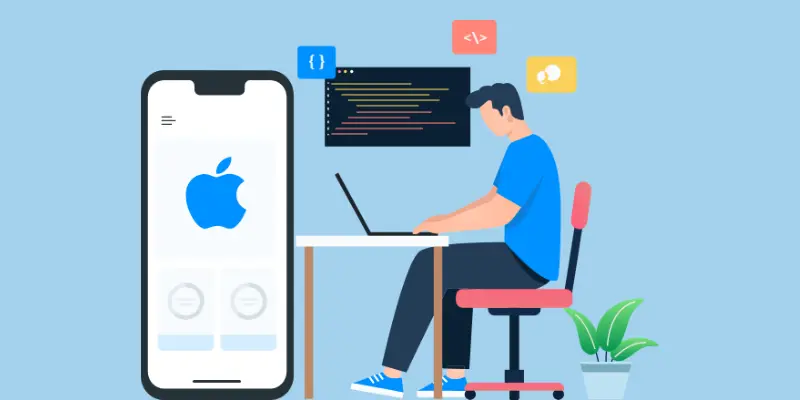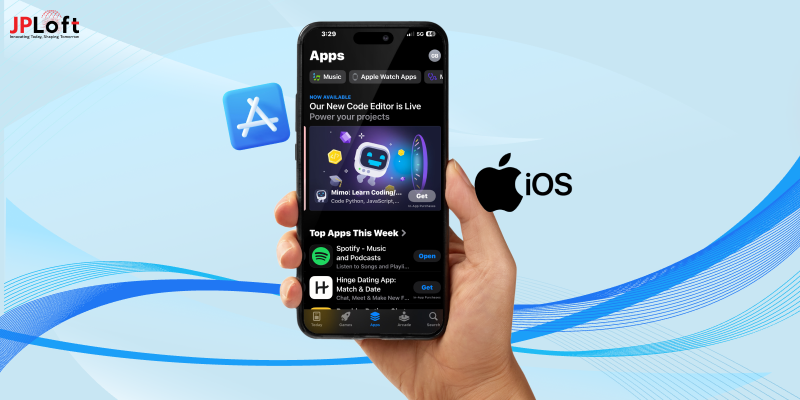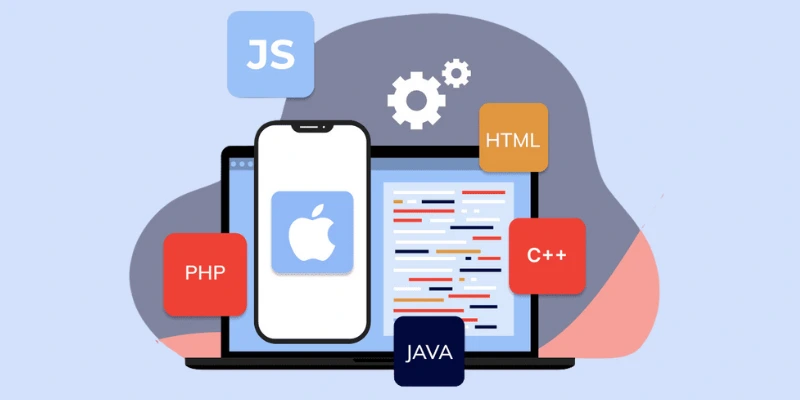In the burgeoning field of mobile app development, developing apps that run on Apple's iOS platform is a challenge that comes with its particular issues. From the strict App Store rules to various features available for devices and operating system variations, iOS developers must navigate a maze of options to create quality apps. At JPLoft, we've resolved the challenges with our creativity and attention to detail and an unwavering commitment to our clients' satisfaction.
This blog will discuss the most common obstacles we face regarding iOS app development and the efficient strategies we employ to overcome them. If you're an experienced app developer or just starting out in this area, these tips will help you optimize the development process of your app, enhance the quality of your application and make sure that your app is seamless from conception and into the App Store.
The Top IOS Challenges application development and ways to get around these challenges
Making iOS apps comes with unique difficulties, whether you're a veteran developer or new to the industry. Overcoming these obstacles can dramatically impact the quality of your application. In this article, we will look at the most challenging issues encountered in iOS application development and present concrete solutions for overcoming them.
Read About: Top Mobile App Development Platforms for iOS Project
Adhering to Apple's Guidelines and Policies
- Challenge:
Apple provides strict guidelines and regulations regarding app submission and acceptance. The guidelines apply to everything from app functionality and user interface layout to privacy and security policies and content standardization. Infractions to these rules could lead to the app's rejection.
Developers need to thoroughly study and follow these rules to ensure the submission process is smooth. That includes keeping up to date with any updates Apple introduces to its guidelines, which could impact application approval times and project plans.
-
Solution:
Get familiar with the Apple App Reviews Guidelines for Stores before beginning development. Check regularly for the latest updates to these guidelines since they are subject to regular change. Continuously test your app to make sure that your app is compliant throughout the development process.
It would be best to consider using iOS Application Development Services, which knows these guidelines, to improve your odds of an app's successful submission. They can assist you in navigating burdensome requirements and lower the chances of rejecting your application, making for a smoother and faster launch.
Making sure that it is compatible with different iOS Software and Versions
-
Challenge:
Ensuring compatibility across various iOS versions and a range of gadgets, such as iPhone, iPad, and iPod touch, is complex. Users may encounter different functions and performance issues based on the device they use and their iOS version.
App fragmentation requires developers to test thoroughly and improve their applications for every configuration, which significantly increases the development process and its difficulty. Solving these issues is vital for ensuring a consistent and smooth user experience across platforms.
-
Solution:
To address compatibility problems, use a reverse-compatible approach to your application. It is essential to prioritize support for the newest iOS versions and ensure robust capabilities for older versions still being used.
Use development tools like Xcode and emulator to thoroughly test your app on various gadgets and iOS versions. Update and patch your application to resolve issues with compatibility which may occur and make sure that users enjoy the same experience across every iOS Versions and platforms.
Managing Performance and Memory Usage
-
Challenge:
Performance issues such as slow load speeds, frequent crashes, and excessive memory consumption can seriously affect the user experience of iOS devices. The operating system can shut down limited resources and apps that require a lot of processor or memory, which could result in a bad user experience and decrease the app retention rate.
Managing memory efficiently and optimizing performance is vital to avoid these issues and ensure a pleasant user experience.
-
Solution:
Optimize your code to maximize efficacy. Utilize tools in Xcode to analyze your application and identify memory leaks and performance bottlenecks. Use efficient code techniques, like lazy loading of resources, to minimize memory use. Test your application regularly under diverse conditions to ensure consistency and efficiency. To improve the performance of your application, Start by improving your code to improve effectiveness.
Make use of Xcode's profiling tools to examine your application in depth and find potential leaks in memory and performance bottlenecks. Follow best practices like lazy loading to manage your resources better and reduce memory usage.
Regular performance tests under diverse conditions are conducted to find problems that might cause problems with the app's stability or speed when you systematically address these issues to ensure better performance and faster user experiences across various devices and situations.
Ensuring Robust Security and Privacy
-
Challenge:
Privacy and security are essential aspects of iOS application development. Ensuring users' personal information is safe from data breaches and unauthorized access is critical. Inadequate security measures could result in serious consequences, such as security breaches of personal information as well as identity theft and the loss of trust between customers.
In addition, non-compliance with the privacy regulations such as GDPR or CCPA could result in substantial costs and legal issues. Developers are required to navigate the complex world of security protocols and legal obligations to protect the personal information of users and their reputations. Ensuring these security concerns are addressed effectively is crucial to providing a secure and reliable app.
-
Solution:
To ensure the most secure level of security for your website, you should implement strong security measures, including encryption of information when it is in transit, safe methods of data storage, and secure communications on networks. Follow the best practices in authorization and authentication, including using OAuth for secured access and token-based authentication to manage sessions. Make sure to regularly update your app to correct any newly discovered security flaws and remain clear of threats that could be posed.
Also, ensure that your app complies with the most essential privacy laws like GDPR and CCPA to safeguard the security of user data and maintain legal compliance. You can increase your app's security and reliability by prioritizing these security measures.
Creation of an Easy User Experience (UX)
-
Challenge:
Designing an intuitive and appealing user interface/UI is the biggest problem. Today, users have high expectations of apps. They expect quality graphics, speed, and smooth and easy navigation. Designing a user interface that achieves the perfect equilibrium between attractiveness and functionality requires a thorough understanding of the user's habits and preferences, ensuring that every aspect of the design contributes to an enjoyable and effortless user experience.
This can be challenging because it requires designing a user-friendly environment and focusing on user-friendliness and accessibility to different screens and device sizes.
-
Solutions:
To design an easy-to-use layout for your iOS application, you must adhere to Apple's Human Interface Guidelines (HIG). These guidelines provide the essential rules to create engaging and intuitive user interfaces. Utilize the native UI elements to maintain uniformity and provide a comfortable user experience.
Always conduct usability tests to gather feedback from actual users. This will allow the app to improve and refine the user interface based on the insights it provides. Utilizing a skilled team of designers and utilizing expert iOS App Development Services can make sure the app's UX/UI will be efficient and reliable, and will result in improved and more enjoyable users.
Handling Network and Connectivity Issues
-
Challenge:
Mobile applications heavily rely on the availability of network connections to run successfully. If the app's users are experiencing inadequate network performance or a lack of connectivity, it could affect the app's functionality and overall experience for users. Poor or unreliable connections may result in delayed responses, inconsistencies with data retrieval, and constant interruptions.
The performance slowdown doesn't just affect users but can reduce engagement and usage. App developers must consider the various network conditions and apply offline capabilities and efficient data processing strategies to alleviate this issue and guarantee an uninterrupted user experience.
-
Solutions:
To ensure your application remains user-friendly and functional regardless of network problems, you must implement solid fallback and error-handling mechanisms. In the case of iPad App Development, this means designing your app to handle network issues by supplying users with helpful errors and alternate actions.
Background tasks are used to carry out crucial tasks even when the application isn't in active usage, and data caching methods are used to save important data locally. It allows users to use essential functions offline, increasing usability in interruptions. The ability to optimize network requests is necessary; think about leveraging technology such as GraphQL to speed up data retrieval and reduce unnecessary data transfers.
Test your application regularly under diverse network conditions to find weaknesses and ensure you can manage disruptions efficiently. In addressing these weaknesses, you can significantly increase your app's resilience and provide your customers with a safer and smoother experience, even in the most challenging networks.
Read Also: Best Practices For iOS App Development in 2024
Balancing Development Speed and Quality
-
Challenge:
Demand for quick application releases in today's highly fast-paced market can lead to an important issue: the risk of the quality of apps can be compromised. The rush to get apps out rapidly can cause unreliable testing and debugging methods, leaving the underlying problems unsolved. It can result in various issues, including frequent performance bugs, unsatisfactory performance, and general user discontent.
Apps that are not adequately tested may suffer crashes, slow loading times, and issues with functionality, which frustrate users and can damage the brand's image. Furthermore, an absence of thorough quality control can result in a poor user experience, which could cause lower ratings or poor reviews.
To reduce the risk, developers must be able to maintain an obligation to strict quality and testing, ensuring that fast launch schedules don't compromise the reliability of the application and the satisfaction of users.
-
Solution:
Implementing agile techniques is vital for successfully balancing quality and speed in developing software. Agile methods, like Scrum or Kanban, allow for regular feedback and iterative development, enabling teams to respond rapidly to changing conditions and produce top-quality outcomes.
CI/CD assures that code changes are tested automatically and integrated, which reduces mistakes made by hand and speeds up deployment while maintaining the highest quality standards. Regularly scheduled code reviews and pair programming are both essential methods. Code reviews can lead to earlier detection of issues and knowledge-sharing among group members.
Likewise, pair programming encourages cooperation and creates better, cleaner code. In addition, taking advantage of the specialized iOS App Development Services can significantly speed up the creation process by offering expert guidance and tools, which ultimately ensures that the product is in line with standards for performance and quality.
Effective Testing and Debugging
-
Challenge:
Thorough testing and debugging are essential to developing an iOS application. However, they pose significant difficulties. Ensuring the application is not prone to bugs and works reliably across various circumstances requires care and thorough testing. iOS apps should be tested on multiple screen sizes, platforms, and iOS versions to ensure compatibility and efficiency.
It includes testing for functionality to ensure that features function correctly, in addition to tests to make sure that users have a smooth experience. Furthermore, testing performance is essential to finding any resource-intensive or bottlenecks.
Debugging, however, can be highly demanding and complicated, frequently necessitating lengthy dives into code and using sophisticated devices to find and solve problems. The nature of iterative testing and debugging requires a comprehensive method to efficiently pinpoint and resolve possible issues.
-
Solution:
Debugging and testing your application effectively is important for ensuring the security and integrity of your program. It would help if you amalgamated manual and automated testing techniques for this. Automated test tools, such as XCTest within Xcode, can adequately test the unit and UI tests, ensuring that the individual components and user interfaces work properly.
On the other hand, manual testing may assist in uncovering issues automated tests could not detect and provide an extensive evaluation of the application's performance and usability. Updating your test scenarios with new features and adjustments is vital to maintain complete coverage during development.
Furthermore, beta testing by using actual users is invaluable because it provides an array of feedback and scenarios that your internal testing may not be able to replicate. Real-world testing may reveal hidden problems and offer insights into user experience, making a cleaner and more usable final product.
Managing Updates and Maintenance
-
Challenge:
The development process continues once an app is launched. Maintaining and updating an application are critical in order to keep it operational and secure over time. This involves adapting to new iOS versions, which may introduce changes that could affect the app's performance or compatibility. It also requires implementing security patches to address vulnerabilities and protect user data.
Additionally, listening to user feedback is vital for identifying and resolving bugs, improving features, and enhancing the overall user experience. Keeping an app updated not only helps in maintaining its relevance but also builds user trust and satisfaction. Regular maintenance ensures the app runs smoothly, adapts to evolving technology, and continues to meet the needs and expectations of its users.
-
Solution:
To effectively manage updates and maintenance, it is crucial to incorporate these elements as integral parts of your development lifecycle. Begin by planning for regular updates and maintenance, ensuring that they are noticed once the app is launched. Proactively monitor user feedback and app analytics to pinpoint areas that require improvement or enhancement.
This will allow you to tackle issues faster and respond to the changing needs of the user more effectively. Additionally, staying compatible with new iOS releases is essential, which means keeping your development tools and libraries up to date to avoid potential conflicts or performance issues.
Engaging continuously with iOS Application Development Services can provide valuable support in maintaining and evolving your app. By integrating these practices, you can ensure your app remains functional, relevant, and user-friendly, ultimately contributing to its long-term success and user satisfaction.
Monetization and User Acquisition
-
Challenge:
Monetizing your app and acquiring a steady user base are two fundamental challenges that can significantly impact your app's success. For many developers and businesses, finding an effective monetization strategy is crucial; it involves choosing between options such as in-app purchases, subscription models, ad revenue, or a combination.
Each method has advantages and drawbacks, and the best choice often depends on the app's target audience and market niche. Equally important is the challenge of user acquisition. Effectively marketing the app to attract and retain users requires a well-thought-out strategy that includes understanding the target audience, leveraging digital marketing channels, and engaging in partnerships or promotions.
Balance between these two aspects could be a challenge, since it demands constant review and constant adjustment of methods to guarantee sustained increase in profitability and growth. Overcoming these challenges is critical to transforming an app from a concept into a successful venture.
- Solution:
To effectively monetize and acquire users for your app, start by exploring various monetization strategies such as in-app purchases, subscriptions, and advertisements to determine which method aligns best with your app's goals and user base. The implementation of robust analytics can be crucial in understanding how users behave and what they prefer that will allow you to tweak your method of monetization, and improve your user experiences.
In addition to these strategies, comprehensive marketing efforts are essential for app growth. This includes running targeted social media campaigns, partnering with influencers who can boost your app's visibility, and optimizing your app store presence through effective App Store Optimization (ASO) techniques.
Additionally, leveraging specialized iOS Application Development solutions can help you seamlessly integrate the most effective monetization techniques and marketing strategies into your app. Combining these elements allows you to maximize revenue potential and achieve sustainable user acquisition growth.
Top Benefits of iPhone App Development

Here are a few of the most important benefits that come with iPhone application creation:
Access to a Premium User Base
One of the significant benefits of creating applications for the iPhone is the ability to tap into a highly-, technologically-savvy,y, and tech-savvy audience. The majority of users on iPhone have higher disposable incomes than those on other platforms, which makes iPhone users more likely to invest in applications, in-app purchases, and subscriptions. The advantage of this demographic will result in higher earnings opportunities for both businesses and developers.
Enhanced Security and Privacy
Apple is known for its commitment to data privacy and user security. iPhone apps can benefit from extensive security options in iOS, including encryption, secure boot chains, and Sandboxing. The robust security framework can help safeguard user information and increase confidence in your app, which is vital in this time of growing cybersecurity risks. Developers benefit from this, which implies fewer security problems and a safer platform for your users.
Streamlined Development Process
The iOS app development platform is extremely efficient. Apple's development tools, like Xcode and Swift, offer a complete and integrated suite of app development tools. The powerful tools in Xcode, like Interface Builder and Simulator, help simplify development and testing procedures. Swift, the Apple programming language, is created for ease of reading and writing, thus reducing the development process and making it easier to repeat.
Consistency Across Devices
iPhone app development is aided by the consistency and reliability of iOS app development, which is aided by the consistency of the iOS ecosystem. Contrary to Android, which runs across various models with different specs, iOS runs on a better-controlled collection of hardware. The uniformity of the hardware ensures that applications work consistently across iPhone versions, thus minimizing the complexity of the testing and optimization of multiple screens and devices.
High App Store Standards
The Apple App Store has rigorous guidelines regarding app approval that ensure a superior level of user experience and quality. This may result in a stricter reviewing process, but it ensures that only the best-functioning apps are accessible to customers. This is for developers. It signifies that their app is better suited to stand out in a market recognized for excellence and creativity.
Strong Market Presence and Brand Value
Making an app that works on iPhone takes advantage of Apple's solid reputation and its brand's value. Its iOS platform is frequently regarded as the benchmark for quality applications, and having an app in the App Store is a great way to increase its visibility. Furthermore, Apple's promotional and marketing initiatives for the latest platforms and operating systems can generate interest and download applications, giving app developers additional benefits.
Advanced Hardware Integration
iPhones have advanced hardware options, like large-resolution displays, high-performance processors, and advanced sensors (e.g., Accelerometer, Face ID, and gyroscope). iOS developers can use these devices' capabilities to build exciting and rich apps. In particular, applications can incorporate the iPhone's enhanced real-time (AR) capabilities or use its impressive processing and graphics capabilities to provide exceptional user experience.
Optimized Performance
Apps designed to run on iPhones usually benefit from superior efficiency optimization. iOS is well-known for its responsive and smooth user interface. It also improves applications' performance. Its software and hardware integration guarantees that applications run smoothly without any bugs or crashes compared with other platforms. This results in an improved and reliable user experience.
Innovative User Experience
Apple is a firm believer in user interface and design. Its Human Interface Guidelines provide developers with a foundation for developing appealing and user-friendly interfaces. If they follow these guidelines, developers can develop apps that meet users' expectations and provide an effortless, top-quality user experience. Designing with a focus helps applications stand out on the App Store and garner favorable reviews from users.
Increased Revenue Potential
Given iPhone customers' tendency to purchase applications and purchases in the app, developers stand a chance to earn more revenue. The App Store supports various monetization options, including the purchase of paid apps, in-app purchases or subscriptions, and ads. With impressive users and a variety of methods of monetization available, iPhone app development can become a profitable venture.
Conclusion
iOS application development comes with various difficulties; however, developers can successfully conquer these hurdles with appropriate strategies. The disparity of different devices and iOS versions demands precise planning and thorough tests to ensure that apps are compatible with the various supported devices. In addition, adherence to strict App Store guidelines and ensuring high-performance standards requires strict quality assurance and optimization strategies.
Security is still a top security issue that requires strong encryption and secure coding methods to safeguard user information. Integrating new technology and features, including augmented reality or machine learning, isn't easy. However, keeping up to date on the latest development tools and frameworks could ease the procedure. Communication between development teams and stakeholders is vital to setting goals and controlling expectations.
In the field of iWatch App development, Developers face distinct issues due to the small screen and the limited capabilities available on wearables. To overcome these issues, developers must design easy-to-use interfaces for users that offer essential functionality but do not overwhelm them. Utilizing watchOS features and optimizing performance will ensure that users have a seamless experience.
FAQs
1. What are some of the biggest problems for iOS app development?
The biggest challenges faced by iOS application development comprise compatibility with devices, user interface (UI) style, application functionality, security, and updating to the latest iOS version and guidelines. These can impact the overall quality and experience.
2. How do I deal with issues with device compatibility with iOS in the development process?
To address issues with device compatibility, developers must ensure that their applications are designed to work with diverse screen sizes and resolutions. Utilizing auto Layout within Xcode can help create a fluid UI that adjusts to different gadgets. Extensive testing with different simulators and devices is also crucial to finding problems with compatibility.
3. Which are the most effective ways to create an intuitive iOS application interface?
The best practices for designing an intuitive iOS application interface are following the Apple Human Interface Guidelines, ensuring an intuitive user experience, using common UI elements, and maintaining aesthetic consistency. Focusing on the user experience (UX) by carrying out user testing and gathering feedback from actual users is essential.
4. How can I ensure that my iOS application performs properly under different situations?
To ensure that apps perform optimally, Developers should concentrate on the most efficient methods of coding, optimize their resource use, and conduct rigorous performance tests. Instruments such as Xcode's Instruments will help detect problems with memory and CPU use, as well as other performance bottlenecks. Continuously updating and maintaining the application also helps to ensure continuous performance.
5. What steps must I consider to safeguard my iOS application?
Securing your iOS application requires implementing top practices such as data encryption and API communication using the security frameworks offered by Apple (e.g., Keychain Services). Developers must also stay up-to-date on the most recent security updates and Apple guidelines. Regular security audits and penetration testing are great ways to detect and repair vulnerabilities












Share this blog